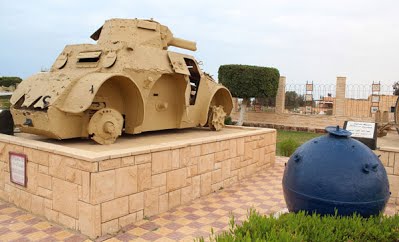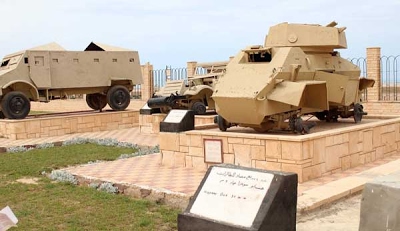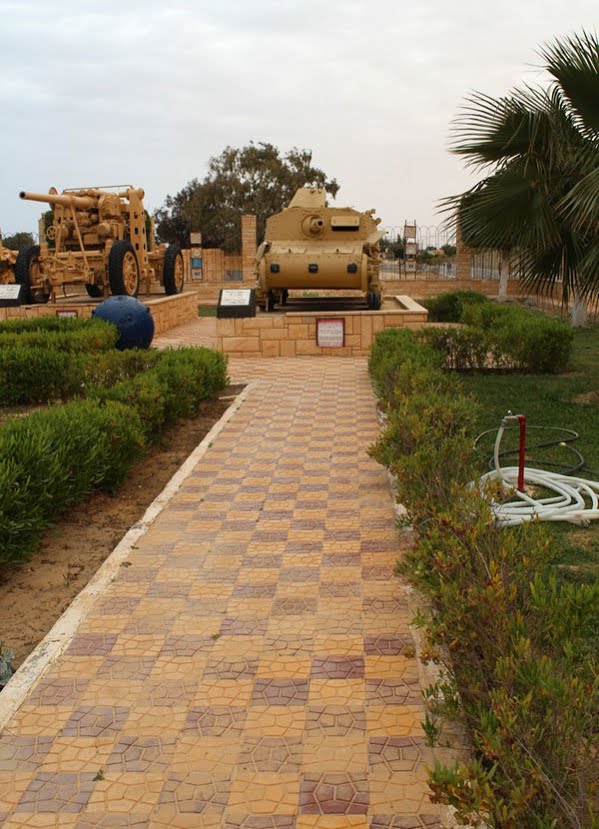Another notable sighting of the paving is at the El Alamein war museum (first drawn to my attention by Pam Garnett [3]), 130 miles North West from Cairo, built as a tourist attraction to mark the scene of the famous tank battles of WW II. More exactly, the paving is not in the museum building itself, but in the surrounding grounds, with the paving surrounding the various relics on display, such as tanks, aeroplanes, artillery etc. and walkways. The sighting is quite extensive; in all instances the pavings surround the relics. Note that the pavings are of the square format types only; there are no single pentagons. Of interest is to how old these are. Details are a little sketchy, with no direct references. Eric Schewe in his blog [1] (from which much of the detail below is obtained) states that in 1950, the Wafd party proposed the idea of a museum, but the 1952 coup interrupted any such plans. Subsequently, what happened next is not known, but the museum finally opened in 16 December 1965 (a plaque marks the occasion), and so they cannot be any earlier. Consequently, the possibility is that the pavings could be relatively old. However, at first impression, these appear quite new, with sharp edges, with little obvious wear and tear visible, and so this conjecture appears false. But that said, with relatively little wear and tear from visitors (in contrast to busy Cairo), and ideal preservation conditions, appearances here may be deceptive, they could well be ‘old’, loosely defined. Of note is that the museum was renovated in 1992, but to what extent remains unclear. Schewe in his blog states that the renovation consisted of the museum itself; with further rooms built, but the grounds were not mentioned. However, these can indeed be dated as installed of the 1992 renovation with near certainty. A recent (December 2014) US correspondent John Gluth [2], upon seeing this page tells me that he was at the Museum in 1990, and the displays as pictured were not what they looked like at his visit. However, there is no photos of this, but even so, this first hand account remains compelling; and so I thus date these as of 1992. As regards documentary evidence as
to when these were instigated, there is a distinct lack of pictures in travel
guide books and articles. Likely, this paucity is on account of relatively
limited interest, and furthermore with El Alamein off the beaten track,
confined to largely with those of interest in war aspects, and so references in
books (and pictures thereof), are very few and far between. Indeed, the only
confirmed instances so far are on the web. The earliest photo on the web is
dated 1999, so these must at least be from that date. Does anyone know of a pre
1999 picture? The picture itself would not necessarily have to be ‘spectacular’
(although ideal!), in that even if there is just a fragment of the paving
showing this would suffice for my purpose. Indeed, given that the pavings completely
surround the relics in all instances, even if the pattern cannot be made out
clearly, one can still thus surmise this. Of course, it is likely that the
paving would ‘feature’ incidentally, in that the photographer would be taking
pictures of the relics per se, the paving appearing by chance (as has occurred
in the instances above). I might just add that even a ‘negative’ picture would
be of interest i.e. of the surroundings of the relics without the
paving, in that one could at least begin to put a date of its instigation, for
instance such as not before such and such a date.
Figure 1 © Pam Garnett Detail Figure 2 © Pam Garnett Paving surrounding artillery Figure 5 © Pam Garnett [1] Eric Schewe blog: https://ericschewe.wordpress.com/2012/07/13/el-alamein-a-no-mans-land-of-egyptian-historical-memory/ [2] John Gluth, email of 17 December 2014 [3] Pam Garnett, email of 16 April 2012 With thanks to Pam Garnett for the sighting and pictures. Created in conjunction with other sightings outside of Cairo 17 April 2012. Rewritten as a distinct page 28 November 2012. Updated 30 December 2014, with John Gluth details, and a general re-write.
|
Cairo Tiling >




